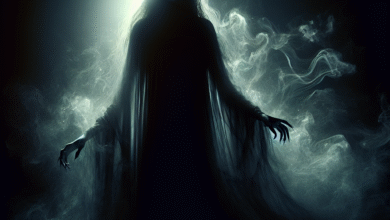The Pale Man: A Haunting Specter of Fear
In the shadowy realm of Guillermo del Toro’s 2006 fantasy film Pan’s Labyrinth, a creature unlike any other lingers—a haunting embodiment of terror known as the Pale Man. With skin the color of old parchment and hollow eyes that devour light, the Pale Man captures the essence of menace and dread. But how did this terrifying entity come to dwell in our cultural psyche? Let’s delve into the origins, folklore, and the echoes of this spectral figure that seep into popular culture.
Origins and Cultural Background
The Pale Man’s origins are steeped in mythology and folklore. While del Toro does not explicitly tie this character to a specific historical figure or legend, the creature exhibits traits reminiscent of various folkloric monsters. In many cultures, the theme of the “child-eating ogre” or the “devourer of innocence” recurs, representing the innate fears of parents regarding loss and the darker aspects of humanity.
In the dark corridors of European fairy tales, one can often find figures lurking who prey upon the unsuspecting—evil stepmothers, witches, and mystic beings who embody the worst fears of childhood and vulnerability. The Pale Man personifies those fears, a spectral guardian of the underworld who embodies the consequences of disobedience, starkly accentuating the idea that curiosity can lead to dire consequences.
The Pale Man’s Appearances
The Pale Man’s most famous appearance unfolds in Pan’s Labyrinth. In the film, he is depicted as a grotesque figure with emaciated limbs and a face marred by hunger. Clad in an unsettling white skin that resembles that of a long-dead corpse, he sits amidst a lavish banquet of food, untouched and waiting. His eerie eyes, which rest not in his sockets, but upon his hands, manifest the primal fear of being watched, of being preyed upon.
Upon Odra, the film’s protagonist, partaking of his feast’s forbidden offerings, the Pale Man awakens, embodying the ultimate punishment for breaking rules. The viewer is captivated by the sheer horror of this tale, accentuated by his insatiable appetite for souls, and the macabre touch of hands devouring children’s essence. His movements are unsettlingly slow yet menacing, amplifying the sense of palpable dread.
Cultural Mirrors and Urban Legends
In various cultures, the Pale Man can be likened to folkloric specters that symbolize punishment for disobedience. Legends of beings like La Llorona in Mexican folklore, who punishes children for perceived misdeeds, parallel the essence of the Pale Man’s cautionary tale. Furthermore, the notion of the Pale Man evokes the fears associated with the loss of innocence—the fear that lurking dangers can transform a moment of curiosity into a nightmare, a relevant theme throughout our own societal narratives.
Although there have been no documented sightings of the Pale Man outside of del Toro’s oeuvre, his character strongly resonates with many who have encountered a version of their own “Pale Man” in different forms—a relentless specter of anxiety, a representation of the unapproachable fears that haunt us in the dead of night. Urban legends often unfold with whispered tales of shadowy figures resembling the Pale Man, living in the periphery of shadowy forests or abandoned places, adding an exhilarating chill to the spine when one hears footsteps in the dark.
The Pale Man in Popular Culture
The Pale Man’s enduring legacy stretches into popular culture, influencing various adaptations and tributes across different mediums. Video games like The Last Guardian and Little Nightmares have drawn upon the character’s silhouette of dread, crafting eerie atmospheres filled with anxieties that can haunt players long after they have ceased to interact with the medium.
Additionally, literature remains steeped in creatures echoing the Pale Man’s unforgiving nature—horror writers frequently conjure monsters resembling this spectral entity to explore the dark underbelly of human nature and societal fears. The symbolism carried by the character has achieved a life of its own beyond del Toro’s vision, enabling the Pale Man to linger in our imaginations, whispering threats from the dark recesses of our psyche.
Creepy Fun Fact
Here’s a chilling urban legend entwined with the Pale Man: Many cultures speak of a “tingling” sensation one might feel near the presence of a watcher—a sure harbinger of misfortune. Children especially tell tales of feeling watched when they gaze into mirrors in dim light, leading to a belief that the Pale Man, or similar entities, may peer back at them from within. Parents may warn their children to avoid midnight snacks, equating desire with danger, as they recall the Pale Man hunger for those who defy boundaries.
In conclusion, the Pale Man remains an unsettling specter of vulnerability and fear, embodying deeper social anxieties and timeless cultural themes, reminding us that in the realm of imagination, darkness often reveals the most profound truths about ourselves. So next time you find yourself nibbling on something forbidden during the witching hours, remember to glance over your shoulder—the Pale Man might just be watching.





